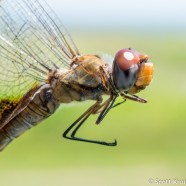Spot-winged Glider
Today was the best day that I have experienced so far this year for migratory insects! Red Admiral and Monarch butterflies were on the wing, and dozens of dozens of dragonflies were zipping by including Common Green Darners, Black Saddlebags, Carolina Saddlebags, Swamp Darners, Wandering Gliders and Spot-winged Gliders (Pantala hymenaea) like this one. You can see the spots of this very difficult to catch species here. Keep an eye out for Sean’s Meet Your Neighbour photo of it sometime soon. So much more life is emerging every day now that we have entered the summer, and it is so...
Read MoreRed-bellied Woodpecker
In our continuing discussion of why the birds are named the way they are, here we see the reason for the name behind the Red-bellied Woodpecker (Melanerpes carolinus). Yes, they have a red head, but not as red as some woodpeckers that go by that name. These birds have pushed north over the last several decades, inhabiting new breeding grounds and in many cases year-round territories. In the last couple of weeks I have noted an influx of Red-bellied Woodpeckers, especially in migratory hot spots, showing how some definitely do move north. We can see that red belly thanks to these views...
Read MoreRadar Migration Overnight April 3, 2015
Here’s a radar grab from the overnight period of April 2 into April 3, 2015. As you can see precipitation is moving across the Northeast and Mid-Atlantic with heavier waves to the west and lighter showers to the east. Midwestern areas had strong and severe thunderstorms while the Atlantic Coast especially had moderate avian migration occurring – see the diffuse and circular areas of blue centered around radar stations contrasting with the green rain. Birds avoiding this wet weather included a lot of sparrows like the White-throated Sparrow, Dark-eyed Junco, Song Sparrow and Swamp...
Read MoreBrown-headed Cowbird Pair
Last week I saw my first Brown-headed Cowbirds of the year, one of the blackbird species well known for making their way north in March. Here you can see a pair feeding in grasslands with the female on the left and the male, sporting his brown head, on the right. The species is a brood parasite, laying their eggs in the nests of other species, with familiar backyard birds like the Yellow Warbler being a common victim. I have seen them feeding the comically enormous fledglings quite often! Scott Kruitbosch Conservation & Outreach Coordinator
Read MoreKilldeers Return
The Killdeer, one of the loudest and most visible late winter/early spring returning species, is moving north rapidly now. As you will likely hear soon enough…they’re back!
Read More








